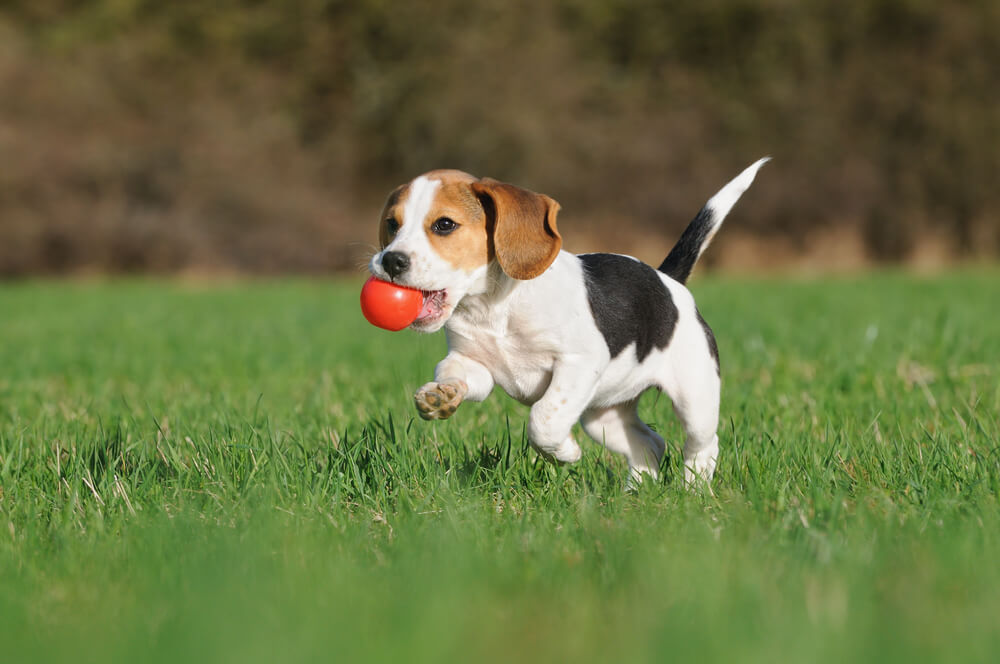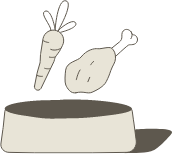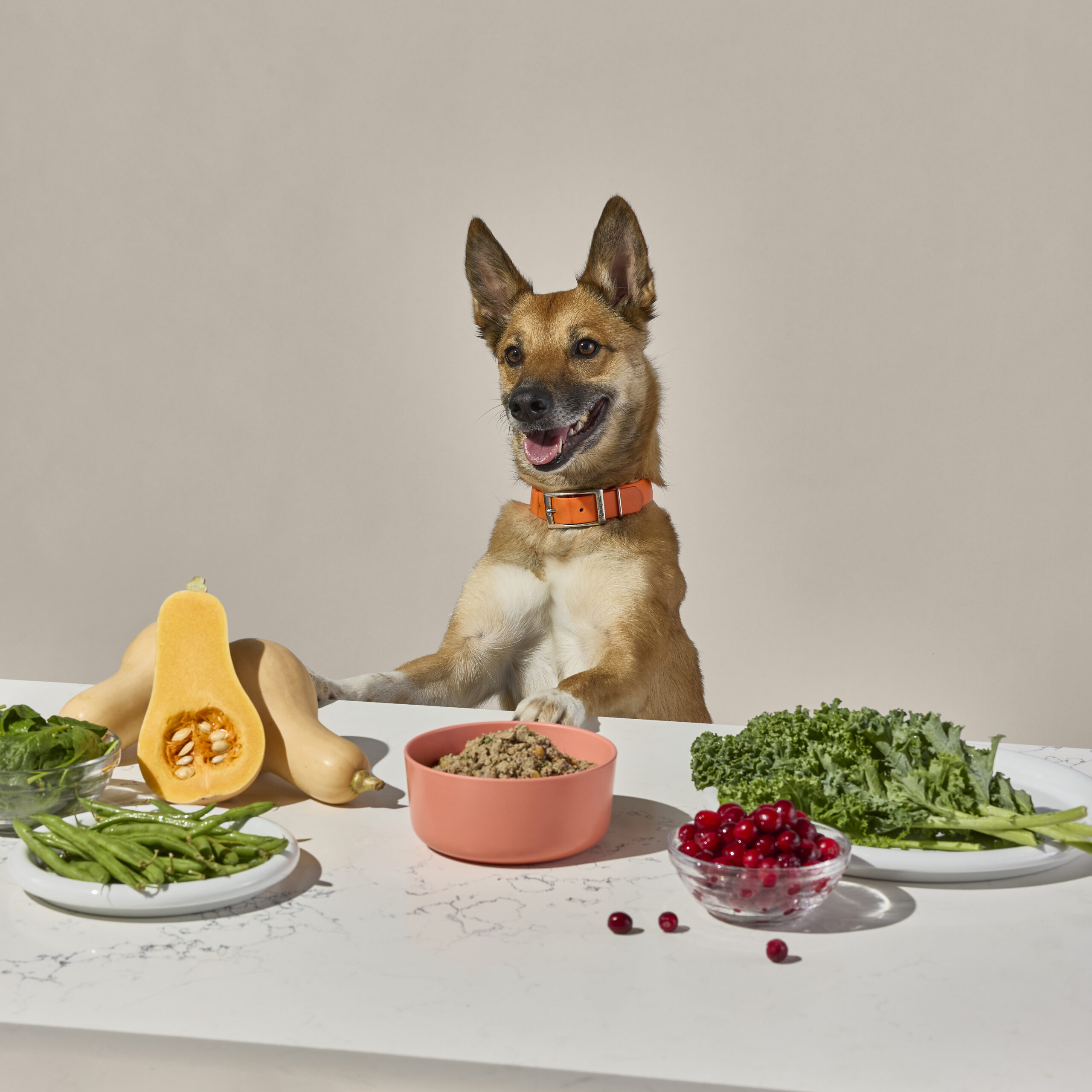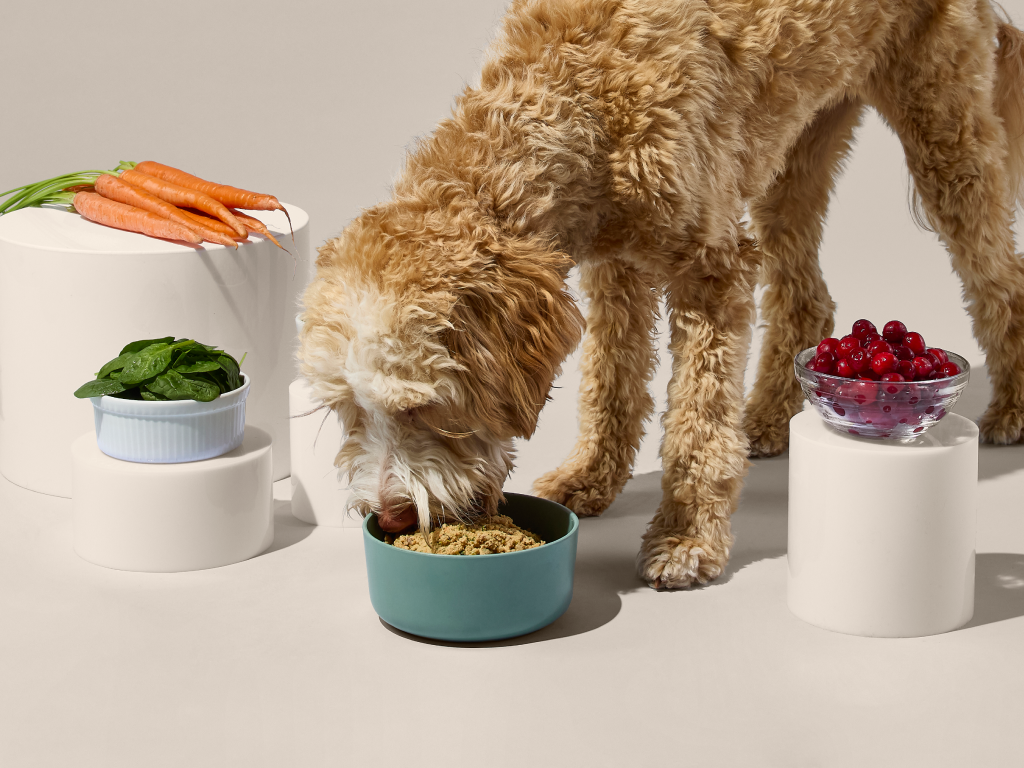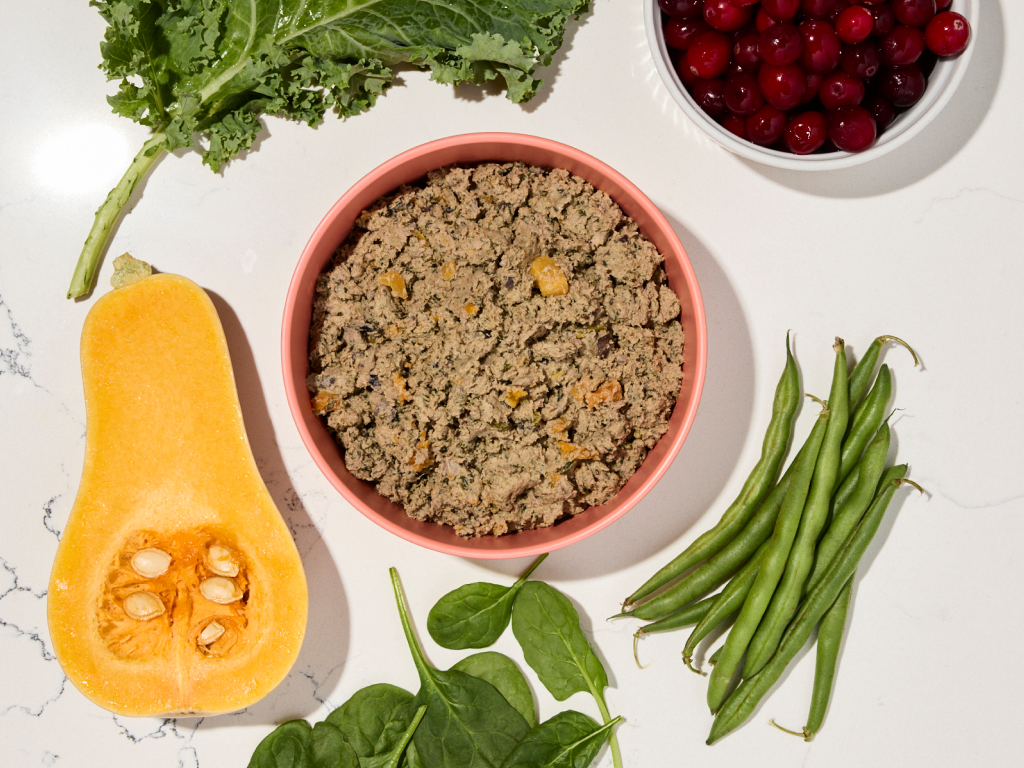Hey Ollie blog readers! We’re offering you an exclusive 60% OFF your starter box! Try now!
Bringing home a new puppy means a lot of excitement—and important nutrition decisions. Because puppies require more calories, fat, protein, and essential nutrients than adult dogs [1], you may wonder which diet options will best support your growing pup. This comprehensive guide will help you understand what makes the best food for puppies and provide new puppy diet recommendations that veterinary nutritionists trust for optimal growth and development.
Understanding Your Puppy’s Unique Nutritional Needs
Why Your Pup Needs Specialized Food
Young puppies need double the amount of food as an adult dog of the same size just to move, grow, and digest food! [2] This isn’t just about feeding larger portions—your puppy requires a specific balance of nutrients that supports their rapid development during these crucial first months.
Essential Nutritional Building Blocks
Protein Requirements for Growing Pups
When selecting the best natural puppy food, you should prioritize options that meet specific protein standards. Diets for growing puppies and reproduction should contain a minimum of 22.5% protein as dry matter or 56.3 grams per 1,000 kcal ME (AAFCO guidelines) [3], compared to just 18% for adult dogs. Protein is the body’s fundamental building block and contributes to healthy muscle development. Protein provides amino acids, several of which are essential for puppies and play important roles in the body, such as tissue development and energy metabolism. [4]
Healthy Fats for Development
The AAFCO minimum levels for fat in dog foods are 8.5% DM for growth and reproduction and 5.5% for adult maintenance. Dietary fat has many roles in the body, such as: Providing energy: Fat is the most concentrated form of energy in pet foods (2.25 times more calories than proteins or carbohydrates). [5]
Why AAFCO Standards Matter for Your Pup
When shopping for puppy food, our veterinarians recommended focusing on foods that meet the standards set by the Association of American Feed Control Officials, or AAFCO. Dog foods carrying the AAFCO stamp are guaranteed to meet certain nutritional and labeling requirements, so you know that what’s on the label is accurate, and the food provides a complete and balanced diet. [6]
Ready to explore premium puppy nutrition options? Discover how Ollie’s fresh approach transforms your pup’s feeding experience.
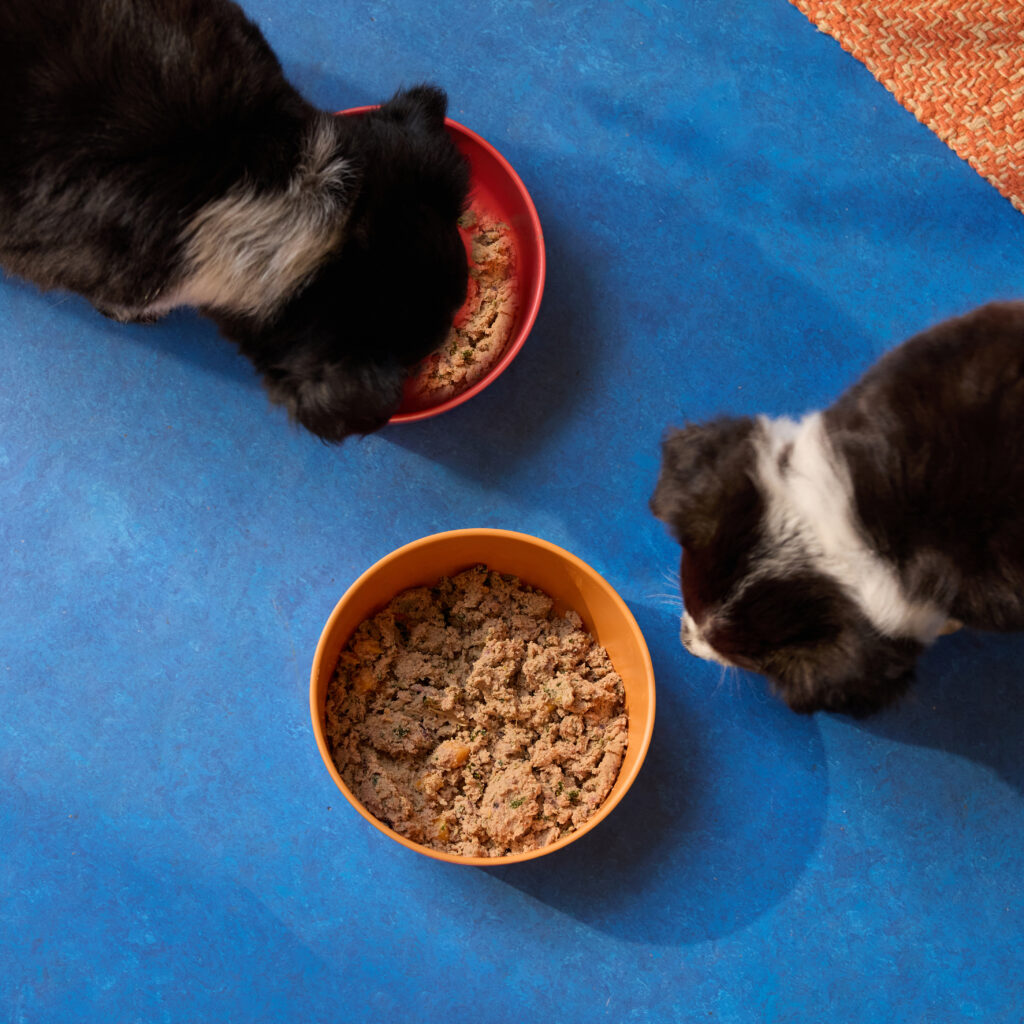
Best Food for Puppies: Top Natural Recommendations
Why Fresh, Human-Grade Nutrition Leads Our Recommendations
When evaluating the best food for new puppies, Ollie’s fresh approach stands out for several compelling reasons. Unlike traditional kibble that sits on shelves for months, Ollie’s fresh puppy food provides the highest quality nutrition through human-grade ingredients and veterinary-formulated recipes.
What Makes Ollie the Best Choice for Your Pup:
- Fresh recipes are 100% human-grade and made with the highest quality meat, fruit, veggies, and grains
- Five nutritious fresh food recipes that are highly digestible and great for developing digestive tracts. Our recipes also provide complete and balanced nutrition full of the essential nutrients your puppy needs
- Ollie works with veterinary nutritionists to craft nutritionally balanced recipes. All of our food is made in North American kitchens using a rigorous testing process that goes above and beyond today’s standards to ensure its safe for your pup
Understanding Personalized Nutrition for Your Pup
What sets the best natural puppy food apart is individualized nutrition. Your German Shepherd puppy has different needs than a Chihuahua, and Ollie’s customized meal plans recognize this reality. Once you’ve completed our quiz, we serve you up meal recommendations based on your pup’s age, weight, breed, activity, and any allergies. We know you know them best, so you can customize any part of your plan, at any time.
Puppy Feeding Guide First Weeks: Establishing Success
8-12 Weeks: Your Pup’s Foundation Period
During your puppy’s first weeks home, establishing a consistent feeding routine supports both nutrition and training. On average, though, a puppy should be fed 4-5 meals a day after they have weaned at 8 weeks, and then 2-3 meals a day until they are 5-6 months old. Feeding little and often fuels rapid growth without overloading little tummies. [7]
| Age | Meals Per Day | Schedule Example |
| 8-12 weeks | 3-4 meals | 7 am, 12 pm, 5 pm, 9 pm |
| 3-6 months | 3 meals | 7 am, 1 pm , 7 pm |
| 6+ months | 2 meals | 8 am, 6 pm |
Your Puppy’s First Week Feeding Schedule:
- In this early stage of their life, you’ll want to feed them 3-4 times per day. [8]
- Take the total amount of food your puppy needs each day and divide that into two to three smaller meals. Give those smaller amounts to him at regular intervals each day. An easy puppy feeding schedule to follow is to feed him when you eat—at breakfast, lunch, and dinner. [9]
Pro Tip for New Pup Parents: For example, feed your puppy’s first meal around 6:30 a.m., second meal at 12:30 p.m., and dinner at 6:30 p.m. Smaller, more frequent meals will help manage your puppy’s fast metabolism and help keep them full throughout the day. [10]
3-6 Months: Transitioning Your Pup’s Schedule
As your pup grows, their feeding needs evolve. Sometime during this period, decrease feedings from four to three a day. [11] At three months, your puppy will be enjoying a solid three meals a day consisting of breakfast, lunch, and dinner, evenly spaced at five-hour intervals. For these, you should divide the daily recommended amount stated on your puppy food label into thirds. [7]
Ready to simplify your puppy’s feeding routine? Explore Ollie’s convenient meal delivery options designed for busy pup parents.
6+ Months: Preparing Your Pup for Adulthood
Begin feeding your puppy twice daily. [11] This transition helps prepare them for adult feeding schedules while ensuring they receive adequate nutrition during continued growth.

Best Food for New Puppy: Breed-Specific Considerations
Large Breed Puppy Nutrition Requirements
If you’re raising a large breed pup, your new puppy diet recommendations must account for controlled growth. AAFCO defines a large breed puppy as any dog whose adult weight is expected to exceed 70 pounds. However, to increase safety, The Dog Food Advisor uses a more conservative 50-pound lower limit for defining large breed puppies. [12]
Critical Considerations for Large Breed Pups:
- For your large or giant breed puppy, you want to find a statement that specifies it has been formulated for the growth of puppies, including large dogs (more than 70lbs adult weight). Choose a food from a company that invests in research and employs an animal nutritionist or veterinary nutritionist to formulate their diets. [4]
- Counterintuitively, that condition has been linked to too much calcium in their diets as puppies. Essentially, too much calcium at an early stage hinders the animal’s body from breaking down old bone. This, in turn, disrupts new bone development at a critical stage in the dog’s growth, leading to lasting health problems throughout his or her life. [13]
Small Breed Puppy Food Recommendations
Small breed pup parents face unique challenges, particularly regarding blood sugar stability. Small-breed puppies may need up to four to six meals a day. Small breeds are prone to hypoglycemia (low blood sugar) if they don’t eat often enough. “This approach ensures a consistent glucose supply, vital for their higher metabolic rates and lower fat reserves,” says Dr. Brad Hinsperger, DVM, director of Kingsdale Animal Hospital. [14]
Top Rated Puppy Nutrition: What to Look For
Essential Ingredients in Healthy Food for New Puppies
When evaluating puppy food recommendations, you should prioritize these key components:
- High-quality protein sources as the first ingredient
- Whole fruits and vegetables for essential vitamins and minerals
- Healthy fats, including omega-3 fatty acid,s for brain and eye development
- Natural preservatives instead of artificial additives
- No fillers or by-products
Red Flags to Avoid in Puppy Food
As pup parents, you should steer clear of foods that:
- Lack AAFCO nutritional adequacy statements
- Contain excessive fillers or by-products
- Include artificial additives and preservatives
- Aren’t specifically formulated for puppy growth
Transitioning to the Best Natural Puppy Food
When you’re ready to switch your pup to healthier nutrition, a gradual transition prevents digestive upset. The key is to transition from one food to another over a week or so, mixing the two to ease the effect on your dog’s digestive system. [7]
7-Day Transition Schedule for Pup Parents
- Days 1-2: 75% old food, 25% new food
- Days 3-4: 50% old food, 50% new food
- Days 5-6: 25% old food, 75% new food
- Day 7+: 100% new food
Ready to make the switch to fresher nutrition? Experience the difference with Ollie’s personalized approach and see how proper nutrition transforms your pup’s health and energy.
When to Transition from Puppy to Adult Food
Understanding when to switch your pup requires attention to their individual development. “The appropriate time to change to adult food is generally anywhere from 6 months to 14 months,” says Ostermeier. Large to giant breed dogs should usually take longer to transition, so they don’t grow as quickly. They typically need to switch after 1 year and even up to 2 years for giant breeds, says Savageau. [15]
It’s best to feed puppy food until your dog has reached at least 80% of their adult size. Small breeds (under 25 pounds at adulthood) usually reach this size around 10–12 months. Medium breeds (25–50 pounds at adulthood), get there around 12–15 months. Large breeds (50 pounds and up at adulthood) typically reach this size between 15–24 months. [10]

Monitoring Your Pup’s Nutritional Success
Healthy Growth Indicators
Puppies should grow between 10 to 15% of their body weight per day, which ranges from about 0.5 ounces to 2.5 pounds per week. [2] Regular weigh-ins help ensure your pup is developing at the appropriate rate.
Signs Your Pup is Thriving
- Consistent energy levels throughout the day
- Healthy, shiny coat and clear skin
- Normal digestion and well-formed stools
- Steady, appropriate weight gain
- Bright eyes and an alert, playful demeanor
Why Pup Parents Choose Ollie for Superior Nutrition
As veterinary nutritionists understand, the best food for puppies combines scientific formulation with fresh, whole ingredients. Ollie’s approach to puppy nutrition addresses every aspect of your growing pup’s needs:
Expert Formulation: Ollie makes it easy to feed your pup fresh, high-quality meals. Our team works with veterinary nutritionists to ensure every recipe meets the highest standards for puppy development.
Convenience Pup Parents Appreciate: No more last-minute trips to the pet store — we deliver your pup’s meals to your door on your schedule. Fresh nutrition has never been more accessible for busy pup parents.
Real Results That Matter: Puppies grow fast, and what you feed them now can shape their health for years to come. Ollie gives them the nutrients they need to thrive from the start. Just wait until you see the tail wags.
Conclusion
Choosing the best food for your puppy sets the foundation for a lifetime of health and happiness. From understanding the unique nutritional requirements of growing pups to establishing proper feeding schedules during those critical first weeks, every decision you make as a pup parent impacts your dog’s development.
The best natural puppy food combines high-quality, human-grade ingredients with veterinary expertise and personalized nutrition. Whether you’re seeking puppy food recommendations for a large breed German Shepherd or healthy food for a small breed Chihuahua, individualized meal plans ensure your pup receives exactly what they need to thrive.
Remember that top-rated puppy nutrition isn’t just about premium ingredients—it’s about consistency, quality, and meeting your pup’s evolving needs throughout their growth journey. By choosing fresh, scientifically-formulated options and maintaining proper feeding schedules, you’re investing in your pup’s long-term health and vitality.
Ready to give your puppy the nutritional advantage they deserve? Start your journey with Ollie’s personalized puppy meal plans.
Frequently Asked Questions
What’s the difference between puppy food and adult dog food? Puppy food contains higher levels of protein, fat, and essential nutrients to support rapid growth and development. Adult food is formulated for maintenance rather than growth, making puppy-specific nutrition crucial during your pup’s first year.
How do I know if my puppy is getting enough nutrition? Monitor your pup’s energy levels, coat quality, growth rate, and overall demeanor. A well-nourished puppy will have consistent energy, a shiny coat, steady weight gain, and bright, alert eyes. Regular veterinary check-ups help ensure proper development.
Can I feed my puppy homemade food? While homemade diets are possible, they require careful planning with a veterinary nutritionist to ensure complete and balanced nutrition. Most pup parents find commercial, veterinary-formulated options like Ollie provide superior convenience and nutritional assurance.
What should I do if my puppy won’t eat? First, rule out health issues with your veterinarian. If your pup is healthy but selective, try fresh, flavorful options with high palatability. Many pup parents find that switching to fresh food resolves picky eating behaviors.
When should I switch my puppy to twice-daily feeding? Most puppies can transition from three meals to two meals daily around 6 months of age. However, individual needs vary based on breed size, metabolism, and development rate. Monitor your pup’s hunger and energy levels to determine the optimal schedule.
Citations
[1] https://dogfoodadvisor.com/best-dog-foods/best-puppy-foods
[2] https://pawlicy.com/blog/how-much-to-feed-a-puppy
[4] https://vcahospitals.com/know-your-pet/nutritional-requirements-of-large-and-giant-breed-puppies
[5] https://petmd.com/dog/nutrition/evr_dg_whats_in_a_balanced_dog_food
[6] https://petmd.com/dog/vet-verified/best-puppy-food
[7] https://uk.pedigree.com/puppy-advice/puppy-feeding/puppy-feeding-schedule
[8] https://pupford.com/blogs/all/puppy-feeding-schedule-11-feeding-tips
[9] https://purina.com/articles/dog/puppy/feeding/how-much-to-feed-a-puppy-chart
[10] https://petmd.com/dog/nutrition/how-much-to-feed-puppy
[11] https://akc.org/expert-advice/nutrition/puppy-feeding-fundamentals
[12] https://dogfoodadvisor.com/frequently-asked-questions/aafco-nutrient-profiles
[13] https://consumersadvocate.org/dog-food
[14] https://rover.com/blog/puppy-feeding-schedule-everything-need-know
[15] https://nbcnews.com/select/shopping/best-puppy-food-rcna151536
Tagged As:

The nutrition your dog needs,
the food they want.

Enjoying our articles? Subscribe our Newsletters and get new articles directly to your inbox
You might also like
17 October 2025
6 MINS READ
Vital Fresh Dog Food Benefits for Your Dog’s Wellness
A longer, happier, healthier life starts with what’s in your dog’s bowl. Nutrition is the foundation of canine wellness, and what you choose to feed your pup has profound, lasting effects on t…
by Ollie Pets
29 September 2025
6 MINS READ
How Is Fresh Dog Food Made?
Unlike standard kibble that undergoes high-heat processing, fresh dog food maintains the natural integrity of ingredients while avoiding artificial additives and fillers. But what exactly goes int…
by Ollie Pets
29 September 2025
7 MINS READ
Is Lamb a Good Protein for Sensitive Stomachs?
Lamb provides significant nutritional benefits for dogs, particularly for pups with sensitive stomachs who need a specialized diet. This protein-rich meat offers an excellent alternative for pups …
by Ollie Pets


